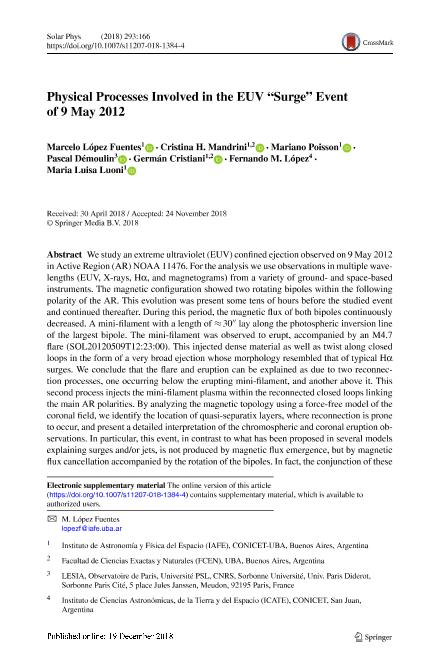Artículo
Physical Processes Involved in the EUV “Surge” Event of 9 May 2012
Lopez Fuentes, Marcelo Claudio ; Mandrini, Cristina Hemilse
; Mandrini, Cristina Hemilse ; Poisson, Mariano
; Poisson, Mariano ; Démoulin, Pascal; Cristiani, Germán Diego
; Démoulin, Pascal; Cristiani, Germán Diego ; López, Fernando Marcelo
; López, Fernando Marcelo ; Luoni, Maria Luisa
; Luoni, Maria Luisa
 ; Mandrini, Cristina Hemilse
; Mandrini, Cristina Hemilse ; Poisson, Mariano
; Poisson, Mariano ; Démoulin, Pascal; Cristiani, Germán Diego
; Démoulin, Pascal; Cristiani, Germán Diego ; López, Fernando Marcelo
; López, Fernando Marcelo ; Luoni, Maria Luisa
; Luoni, Maria Luisa
Fecha de publicación:
12/2018
Editorial:
Springer
Revista:
Solar Physics
ISSN:
0038-0938
Idioma:
Inglés
Tipo de recurso:
Artículo publicado
Clasificación temática:
Resumen
We study an extreme ultraviolet (EUV) confined ejection observed on 9 May 2012 in Active Region (AR) NOAA 11476. For the analysis we use observations in multiple wavelengths (EUV, X-rays, Hα , and magnetograms) from a variety of ground- and space-based instruments. The magnetic configuration showed two rotating bipoles within the following polarity of the AR. This evolution was present some tens of hours before the studied event and continued thereafter. During this period, the magnetic flux of both bipoles continuously decreased. A mini-filament with a length of ≈30″ lay along the photospheric inversion line of the largest bipole. The mini-filament was observed to erupt, accompanied by an M4.7 flare (SOL20120509T12:23:00). This injected dense material as well as twist along closed loops in the form of a very broad ejection whose morphology resembled that of typical Hα surges. We conclude that the flare and eruption can be explained as due to two reconnection processes, one occurring below the erupting mini-filament, and another above it. This second process injects the mini-filament plasma within the reconnected closed loops linking the main AR polarities. By analyzing the magnetic topology using a force-free model of the coronal field, we identify the location of quasi-separatix layers, where reconnection is prone to occur, and present a detailed interpretation of the chromospheric and coronal eruption observations. In particular, this event, in contrast to what has been proposed in several models explaining surges and/or jets, is not produced by magnetic flux emergence, but by magnetic flux cancellation accompanied by the rotation of the bipoles. In fact, the conjunction of these two processes, flux cancellation and bipole rotations, is at the origin of a series of events, homologous to the event we analyze in this article, which occurred in AR 11476 from 8 to 10 May 2012.
Archivos asociados
Licencia
Identificadores
Colecciones
Articulos(IAFE)
Articulos de INST.DE ASTRONOMIA Y FISICA DEL ESPACIO(I)
Articulos de INST.DE ASTRONOMIA Y FISICA DEL ESPACIO(I)
Articulos(ICATE)
Articulos de INST.D/CS ASTRONOMICAS D/LA TIERRA Y DEL ESPACIO
Articulos de INST.D/CS ASTRONOMICAS D/LA TIERRA Y DEL ESPACIO
Citación
Lopez Fuentes, Marcelo Claudio; Mandrini, Cristina Hemilse; Poisson, Mariano; Démoulin, Pascal; Cristiani, Germán Diego; et al.; Physical Processes Involved in the EUV “Surge” Event of 9 May 2012; Springer; Solar Physics; 293; 12; 12-2018; 165-192
Compartir
Altmétricas



